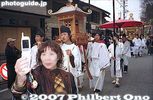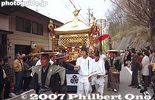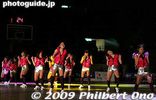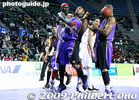 Image search results - "pro" Image search results - "pro" |

The Sanno Matsuri Festival is one of Japan's Big Three Festivals and one of Tokyo's Big Three Festivals held in mid-June during several days. The main highlight is the Jinko-sai Procession held every two years. The 600-meter long procession consists of about 500 people parading through central Tokyo near the National Diet, Imperial Palace, Tokyo Station, and Ginza. It includes three portable shrines, carriages, and flower floats. Various events are also held at Hie Shrine which holds the festival. Jinko-sai Procession left Hie Shrine at 8 am on June 11, 2004. Before noon, they approach the Imperial Palace. 山王まつり神幸祭
|
|

The Jinko-sai Procession passes in front of the Imperial Palace.
|
|

For a procession this large and grand, the crowd of spectators was extremely sparse. Good for photographers like me, but it was strange.
|
|
|

Hie Shrine's Sanno Matsuri Jinko-sai Procession in front of Imperial Palace.
|
|
|

One of the three portable shrines.
|
|

The original procession included many high floats. However, due to overhead power lines and overpasses, such floats cannot be included.
|
|
|
|

Omiko Shrine maidens
|
|

Flower float, Sanno Matsuri
|
|

In front of Tokorozawa Aviation Museum is a Curtiss-Wright C-46 transport plane.
|
|
|
|

The C-46 was used by the Japan Air Self-Defense Forces for cargo transport from the 1950s.
|
|
|

Monument for Japan's Birth of Aviation 日本の航空発祥の地・所沢
|
|

Rest stop near Sakashita-mon Gate at the Imperial Palace.
|
|

Warrior monk procession 僧兵行列
|
|
|

It is unusual or unique to see such a procession for Setsubun. 僧兵行列
|
|
|
|

In 1951 when they were rebuilding the temple destroyed by the war, they found some items which were supposedly used by a warrior monk. 僧兵行列
|
|
|

Shrine maidens dance in front of the three portable shrines near Sakashita-mon Gate.
|
|

So from 1953, as part of the Setsubun ceremonies on Feb. 3, they started this procession of people dressed as warrior monks.
|
|
|

They are not real warrior monks. Monks do not go to battle as they once did centuries ago. Also see the video at YouTube. 僧兵行列
|
|
|

Rear view
|
|
|

Warrior monks entering Hosenji temple. 僧兵行列
|
|
|

This man must be the leader.
|
|

During this break period, the shrine priest and other representatives enter the Imperial Palace to pray for the peace, happiness, and prosperity of the Imperial family. Hie Shrine is the only shrine in Japan bestowed with this privilege.
|
|

Blowing a conch shell. One of the signals of battle.
|
|
|

The warrior monk costume is interesting. The collar makes them look bigger and more fearsome. 僧兵行列
|
|

Some entertainment.
|
|

The procession started at 3:30 pm at a nearby shrine.
|
|
|

They arrived Hosenji at around 4 pm.
|
|
|
|
|

Memorial service 柴燈大護摩供
|
|
|
|
|
|
|

The procession passes by Tatsumi Turret as it leaves the Imperial Palace.
|
|
|
|

Instrument players
|
|
|
|
|

柴燈大護摩供
|
|

The Land Procession is one of the festival's two main events. It starts with a group of taiko drummers.
|
|

Shrine officials in the procession.
|
|

A mikoshi passes by Tatsumi Turret of the Imperial Palace durng the Sanno Matsuri Jinko-sai.
|
|

Setting afire
|
|

Taiko drummers at the shrine's Otorii gate. 催太鼓
|
|
|
|

柴燈大護摩供
|
|
|
|
|

Sarutahiko on horseback 猿田彦
|
|

Shrine maidens
|
|
|

About 3,000 people are in the procession which follows a 4 km route from the shrine to a boat landing near Tenjin-bashi Bridge on the Okawa River. 陸渡御
|
|

Mikoshi
|
|
|
|

Shrine maidens
|
|

Road to Tokyo Station.
|
|

Danjiri float 地車
|
|

Shrine maidens
|
|

Crossing the street.
|
|

Danjiri float 地車
|
|
|
|

Shishimai lion dance
|
|
|
|

All the auto traffic and urban noise robbed the dignity of the solemn procession.
|
|
|

A middle-aged woman uses her camera phone to photograph herself. "I was here!"
|
|

Crossing the street near Maru-biru Building. They proceeded to Tokyo Station, Kyobashi, Nihonbashi, Shimbashi, and Ginza before returning to Hie Shrine at 5:30 pm.
|
|

Lion dance
|
|

Portable shrine 神輿
|
|

Map of Jinko-sai Route.
|
|

Hanagasa dancers 花傘
|
|

Portable shrine 神輿
|
|

On the next day on June 12, 2004, was Miya-iri or portable shrines entering Hie Shrine. Led by this cart of festival musicians. 山王まつり宮入り
|
|

花傘
|
|

Shrine priest
|
|
|
|
|

Hanagasa umbrella dancers 花傘
|
|

Parish members reach the shrine.
|
|

Hanagasa umbrella dancers, Tenjin Matsuri, Osaka 花傘
|
|
|
|
|
|
|
|
|
|

Chigo child
|
|
|

牛曳童児
|
|

Shrine priest
|
|

御羽車
|
|

Portable shrine 御羽車
|
|

Mother and twins in yukata
|
|
|
|
|
|
|
|
|
|

Portable shrine housing the spirit of Sugawara Michizane. This is the most important thing in the procession. 御鳳輦
|
|
|
|
|

By 6 pm, shrine parishioners started boarding boats near Tenjin-bashi Bridge, the starting point of the Boat Procession. These are supporter's boats.
|
|

These boats will carry portable shrines.
|
|

A large crane is used to carry the portable shrines onto the boats.
|
|

The Boat Procession started at 7 pm on Okawa River. These boats are called Dondoko. どんどこ船 大川 船渡御
|
|

The Boat Procession (Funa-togyo) is the Tenjin Matsuri festival's main event.
|
|
|

The boats are numerous. About 100 of them go up and down the river.
|
|

Most of the boats carry parishioners who eat bento on the boats while sometimes looking at photographers shooting them from a bridge overhead.
|
|

Okawa River 大川
|
|

The boats are large barges.
|
|

To ride these boats, you have to be a member of a shrine parish or supporting group.
|
|

船渡御
|
|
|

The fire, fueled by LP gas, is on a corporate-sponsored boat, used for illumination. 大篝
|
|
|

Tugboats pull these huge barges.
|
|

Ningyo-bune 人形船
|
|
|
|

Boat corner
|
|
|
|
|

船渡御
|
|

船渡御
|
|
|
|
|
|

The boat carrying the portable shrine housing the spirit of Sugawara Michizane. 御鳳輦奉安船
|
|

This is the most important boat in the procession. It holds a ceremony called the Senjo-sai (船上祭) in the middle of the river to celebrate Sugawara Michizane's birthday. 御鳳輦奉安船
|
|

玉御神輿奉安
|
|

Portable shrine 船渡御 玉御神輿奉安
|
|

Horrendous crowd gathers to watch the fireworks, the festival's climax. The festival ends at 10 pm when the procession returns to the shrine.
|
|

Sign near Bannaji temple saying that the warrior procession would start at 7 pm.
|
|

On the way to Bannaji temple, this statue of the Ashikaga lord.
|
|

Gate to Bannaji temple. It is actually an arched bridge.
|
|

Gate to Bannaji temple.
|
|

Behind the gate to Bannaji temple.
|
|

After going through the gate, there's this path to the temple hall. Now lined with food stalls during the festival.
|
|

Plum trees
|
|

Bannaji temple main hall. National Treasure built by Ashikaga Takauji's father. A rare example of a main temple hall from the Kamakura Period.
|
|

Carrying wooden boxes of beans.
|
|

At one point along the procession route (a major road), there was a rest station where they served free ama-zake (sweet sake). The hot drink warmed us up.
|
|

On Feb. 3, the Yoroi Toshikoshi Shuko festival is held in the evening with a warrior procession going to Bannaji. Start of the warrior procession consisting of local children, men, and women. The procession started at Orihime Kominkan. 織姫公民館
|
|

Since it is held at night in the middle of winter, dress warmly.
|
|
|

Going over the arched bridge at Bannaji temple.
|
|
|
|
|
|
|
|
|

Yoroi Toshikoshi Shuko festival, Ashikaga, Tochigi.
|
|
|
|

Once in a while, they would shout a war cry.
|
|
|
|
|
|
|
|

Yoroi Toshikoshi Shuko festival, Ashikaga, Tochigi.
|
|
|
|
|
|
|
|
|
|
|
|
|
|
|

I saw at least two foreigners also dressed up as well.
|
|
|
|
|
|

Yoroi Toshikoshi Shuko festival, Ashikaga, Tochigi.
|
|

They all entered Bannaji temple by crossing the narrow arched bridge.
|
|
|
|
|
|
|

Within the grounds of Bannaji temple, they all gathered at this small outdoor stage.
|
|

After a few speeches, they got boxes of beans and threw them at us, but only the people up front got hit with beans.
|
|

The bean throwing was very short, both time-wise and distance-wise.
|
|
|
|
|
|

The bean-throwing was disappointing at Yoroi Toshikoshi Shuko festival in Ashikaga, Tochigi. Few beans and they hardly reached anybody.
|
|

Japan's oldest school.
|
|
|

Entrance to Ariake Colosseum for the game between Tokyo Apache and Toyama Grouses on Dec. 27, 2008.
|
|

Sign for Tokyo Apache vs. Toyama Grouses on Dec. 27, 2008.
|
|

Division standings as of Dec. 21, 2008. Tokyo Apache in 1st place, and Grouses in last place among the six teams in the Eastern conference of the bj-league.
|
|

Uniform replica for sale.
|
|

T-shirts for sale.
|
|

Towels
|
|

Join the Tokyo Apache booster club.
|
|

Pregame entertainment by the Tokyo Apache Dance Team (equivalent to cheerleaders). Unfortunately, pro basketball is still a minor sport in Japan. Few people klnow about the bj-league and the teams. Many people in Tokyo have never heard of Tokyo Apache.
|
|

It's a shame because it's quite entertaining to watch bj-league basketball games. They are geared for entertainment before and during the game.
|
|

Ticket prices are also inexpensive. Perhaps they should offer 500 yen tickets on special campaign days so more people will come out to watch.
|
|

The basketball players also service the fans with autographs and handshakes before and after the game.
|
|

Tokyo Apache team members are introduced as they go through a gauntlet of cheerleaders.
|
|

Ariake can get quiote cold in winter though. They might turn on the heater or they might not.
|
|
|
|
|

The Tokyo Apache Dance Team girls swirl around as the player passes through.
|
|

Some practice shots.
|
|
|

Tip off
|
|

John "Helicopter" Humphrey
|
|
|
|

Masashi Joho
|
|
|
|
|

Tokyo Apache Dance Team do their stuff during time outs. They are the cheerleaders who appear on Saturday games.
|
|
|
|
|
|
|

Half-time show by Tokyo Apache Dance Team.
|
|

Darin Maki
|
|
|
|

A foul by Babacar Camara led to a brief scuffle between him and John Humphrey. After some deliberation by the referees, both were expelled from the game.
|
|
| 1866 files on 8 page(s) |
1 |
 |
 |
 |
 |
|